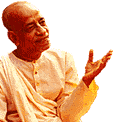Chapter 2: Contents of the Gita Summarized
Bg 2.61
TEXT 61
tani sarvani samyamya
yukta asita mat-parah
vase hi yasyendriyani
tasya prajna pratisthita
yukta asita mat-parah
vase hi yasyendriyani
tasya prajna pratisthita
SYNONYMS
tani—those senses; sarvani—all; samyamya—keeping under control; yuktah—being engaged; asita—being so situated; mat-parah—in relationship with Me; vase—in full subjugation; hi—certainly; yasya—one whose; indriyani—senses; tasya—his; prajna—consciousness; pratisthita—fixed.
TRANSLATION
One who restrains his senses and fixes his consciousness upon Me is known as a man of steady intelligence.
PURPORT
That the highest conception of yoga perfection is Krsna consciousness is clearly explained in this verse. And, unless one is Krsna conscious, it is not at all possible to control the senses. As cited above, the great sage Durvasa Muni picked a quarrel with Maharaja Ambarisa, and Durvasa Muni unnecessarily became angry out of pride and therefore could not check his senses. On the other hand, the King, although not as powerful a yogi as the sage, but a devotee of the Lord, silently tolerated all the sage's injustices and thereby emerged victorious. The King was able to control his senses because of the following qualifications, as mentioned in the Srimad-Bhagavatam:
sa vai manah krsna-padaravindayor
vacamsi vaikuntha-gunanavarnane
karau harer mandira-marjanadisu
srutim cakaracyuta-sat-kathodaye
vacamsi vaikuntha-gunanavarnane
karau harer mandira-marjanadisu
srutim cakaracyuta-sat-kathodaye
mukunda-lingalaya-darsane drsau
tad-bhrtya-gatra-sparse'nga-sangamam
ghranam ca tat-pada-saroja-saurabhe
srimat-tulasya rasanam tad-arpite
tad-bhrtya-gatra-sparse'nga-sangamam
ghranam ca tat-pada-saroja-saurabhe
srimat-tulasya rasanam tad-arpite
padau hareh ksetra-padanusarpane
siro hrsikesa-padabhivandane
kamam ca dasye na tu kama-kamyaya
yathottamasloka-janasraya ratih
siro hrsikesa-padabhivandane
kamam ca dasye na tu kama-kamyaya
yathottamasloka-janasraya ratih
"King Ambarisa fixed his mind on the lotus feet of Lord Krsna, engaged his words in describing the abode of the Lord, his hands in cleansing the temple of the Lord, his ears in hearing the pastimes of the Lord, his eyes in seeing the form of the Lord, his body in touching the body of the devotee, his nostrils in smelling the flavor of the flowers offered to the lotus feet of the Lord, his tongue in tasting the tulasi leaves offered to Him, his legs in traveling to the holy place where His temple is situated, his head in offering obeisances unto the Lord, and his desires in fulfilling the desires of the Lord...and all these qualifications made him fit to become a mat-parah devotee of the Lord." (Bhag. 9.4.18-20)
The word mat-parah is most significant in this connection. How one can become a mat-parah is described in the life of Maharaja Ambarisa. Srila Baladeva Vidyabhusana, a great scholar and acarya in the line of the mat-parah, remarks: "mad-bhakti-prabhavena sarvendriya-vijaya-purvika svatma drstih sulabheti bhavah." "The senses can be completely controlled only by the strength of devotional service to Krsna." Also the example of fire is sometimes given: "As the small flames within burn everything within the room, similarly Lord Visnu, situated in the heart of the yogi, burns up all kinds of impurities." The Yoga-sutra also prescribes meditation on Visnu, and not meditation on the void. The so-called yogis who meditate on something which is not the Visnu form simply waste their time in a vain search after some phantasmagoria. We have to be Krsna conscious—devoted to the Personality of Godhead. This is the aim of the real yoga.
Copyright (c) 1972 by His Divine Grace A.C. Bhaktivedanta Swami Prabhupada











